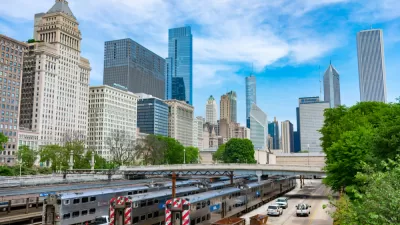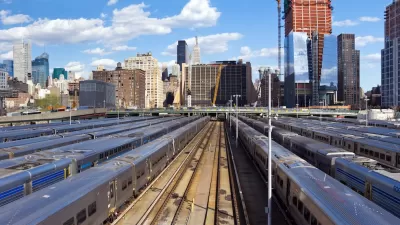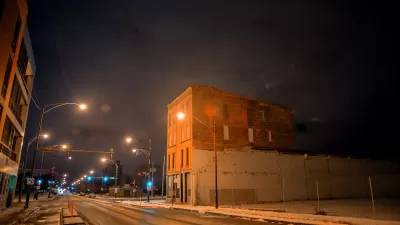Transit-oriented development has ramped up in Chicago, but racial and economic inequities have come along with it. A proposed ordinance would expand TOD zones while also preventing displacement of residents.

Chicago passed a transit-oriented development ordinance in 2013 as well as an initiative last year focused on TODs along high-ridership bus corridors in the city. "If a land parcel is located within a quarter-mile (two full blocks or a roughly five-minute walk) of a designated bus line segment, that parcel is eligible for reductions in required parking and increases in height and density," reports David Zegeye.
As these projects have moved forward, however, concerns about displacement in low-income communities and communities of color have become an issue, particularly in areas where upscale TOD projects mean less affordable housing. Mayor Rahm Emanuel last week introduced a new ordinance to expand the city’s TOD zones and support equitable TOD, says Zegeye:
Unlike previous versions of Chicago’s TOD ordinance, the new legislation explicitly mentions using TOD as a strategy for increasing racial and economic equity. Stated goals include "Avoiding displacement of residents, small businesses, cultural institutions, and community organizations" and "Encouraging investment in communities of color and low-income communities and appropriately addressing various market conditions."
The goal of the ordinance is to encourage TODs in underserved parts of the city, including Chicago's South Side and West Side neighborhoods. The TOD bus corridors also align with areas the city hopes to revitalize using local economic development and federal Opportunity Zone funding.
FULL STORY: How Chicago’s New Bus TOD Ordinance Could Help Underserved Communities

Manufactured Crisis: Losing the Nation’s Largest Source of Unsubsidized Affordable Housing
Manufactured housing communities have long been an affordable housing option for millions of people living in the U.S., but that affordability is disappearing rapidly. How did we get here?

Americans May Be Stuck — But Why?
Americans are moving a lot less than they once did, and that is a problem. While Yoni Applebaum, in his highly-publicized article Stuck, gets the reasons badly wrong, it's still important to ask: why are we moving so much less than before?

Research Shows More Roads = More Driving
A national study shows, once again, that increasing road supply induces additional vehicle travel, particularly over the long run.

Jane Goodall Inspires with Message of Hope, Resilience, and Environmental Action
Speaking in Pasadena, Jane Goodall offered a hopeful and inspirational message, urging global compassion, environmental responsibility, and the power of individual action to shape a better future.

Harnessing the Power of Fungi for Environmental Cleanup
Mycoremediation — the use of fungi to break down or absorb environmental pollutants — offers a promising, cost-effective, and eco-friendly alternative to conventional methods for restoring contaminated sites.

For Advice on Accessibility, Look to Iceland
Cities around the country installed over 1,700 wheelchair ramps in the last five years, thanks in part to one man’s initiative.
Urban Design for Planners 1: Software Tools
This six-course series explores essential urban design concepts using open source software and equips planners with the tools they need to participate fully in the urban design process.
Planning for Universal Design
Learn the tools for implementing Universal Design in planning regulations.
Heyer Gruel & Associates PA
City of Moreno Valley
Institute for Housing and Urban Development Studies (IHS)
City of Grandview
Harvard GSD Executive Education
NYU Wagner Graduate School of Public Service
City of Cambridge, Maryland
Newport County Development Council: Connect Greater Newport





























